
A dipole encounters a monopole
monopole nearly as strong / encounter head-on
A Lamb dipole with radius 0.75 and
velocity of +2 (i.e. moving to the right) is placed to the
left of a positive Bessel monopole
with radius 0.50 at the origin.
In the main run of this example the
dipole is along the x-axis, making the encounter head-on, and
the monpole has a circulation of +4, which means that the monopole is
weaker than each dipole half.
In this example:
-
The circulation of the monopole is +8, which makes the monopole
nearly as strong
as each dipole half, since the circulation per dipole half is about 10.2.
-
The dipole is located at the x-axis:
the encounter is head-on.
The initial situation is shown in the following two graphs:
-
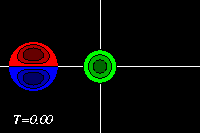
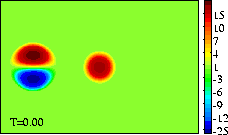
-
Initial tracer (left) and vorticity (right) distribution.
The domain shown is x=[-3.0:+3.0], y=[-2.0:+2.0].
The extrema of voriticity are +/- 29.5 for the dipole
and +23.6 for the monopole.
The monopole has an angular momentum: it rotates about its central point,
without moving.
The dipole has a linear momentum: it moves in the direction of its axis, in
this case to the right, towards the monopole.
The monopole rotates counter-clockwise, like the top half of the dipole.
The result of the rotation is that the dipole is pushed down, to negative
y-values, while it moves towards the monopole, like in the
main run without offset.
Since the monopole (green is in this example stronger, the deformation of
the positive dipole half (red) is larger and the dipole is pushed further
to negative y-values. This can be seen clearest in the tracer plots:
-

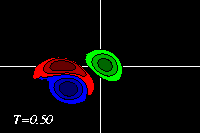
Due to the approach of the dipole, the monopole is deformed slightly and
pushed away from its initial location.
The deformation of the positive dipole half (red) continues and it
effectively is squeezed against the positive monopole (green) and the
two form a positive vorticity patch, and a new dipole is formed:
-
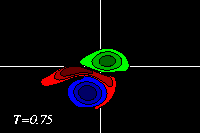
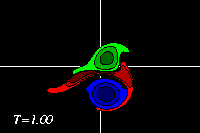
-
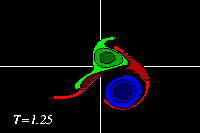
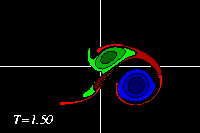
The original positive dipole half (red) is entirely torn apart in this
proces: part of its vorticity is around the original positive monopole
(green), part is around the negative dipole half (blue), and part is in a
vorticity tail, which also contains some of the vorticity from the original
monopole:
-
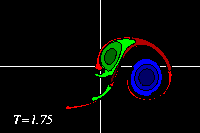

-
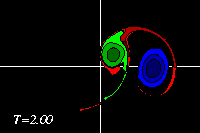

The dipolar structure thus formed is evidently a-symmetric, so that it
follows a curved path, leaving behind a tail of vorticity.
The dipolar structure thus formed is clearly not very tight, but as there
is no other vortex present it will move as a dipole. Since it is
a-symmetric, the path it follows is curved.
-
These MPEG movies (81 frames; 456kb) show the evolution until T=2
more clearly:
-
===>
MPEG movie of the tracer distribution
-
===>
MPEG movie of the vorticity distribution
At initialisation, a single tracer particle was placed at the extrema of
vorticity of both vortices. The next graph shows their trajectories:
-
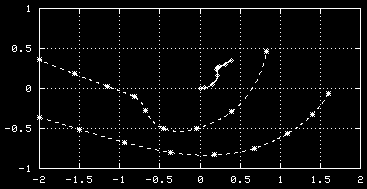
-
Trajectories of the tracers, initially placed at
the extrema of vorticity of the monopole (solid
line) and the dipole (dashed line).
Symbols are placed at intervals of T=0.25.
Some further remarks
See the main run of this example,
with a weaker monopole and a head-on encounter.
The evolution of the vorticity distribution is computed with a
Finite Difference Method
which solves the two-dimensional vorticity (Navier-Stokes) equation.
Time and distances are given in dimensionless units.
===> Some details on the computation presented
on this page for those who are interested.
<=== Numerical simulations of 2D vortex
evolution with a Finite Difference Method.
 Jos van Geffen --
Home |
Site Map |
Contact Me
Jos van Geffen --
Home |
Site Map |
Contact Me
created: 21 September 1999
last modified: 26 May 2001
















 Jos van Geffen --
Home |
Site Map |
Contact Me
Jos van Geffen --
Home |
Site Map |
Contact Me